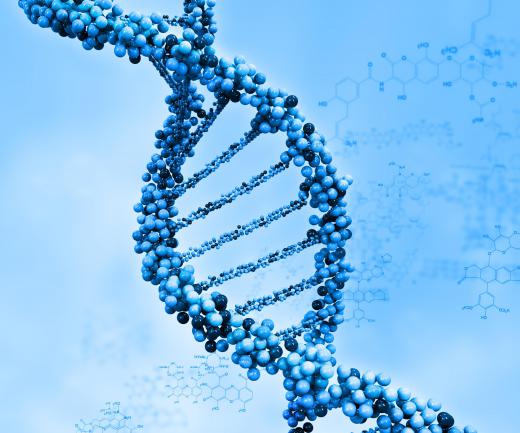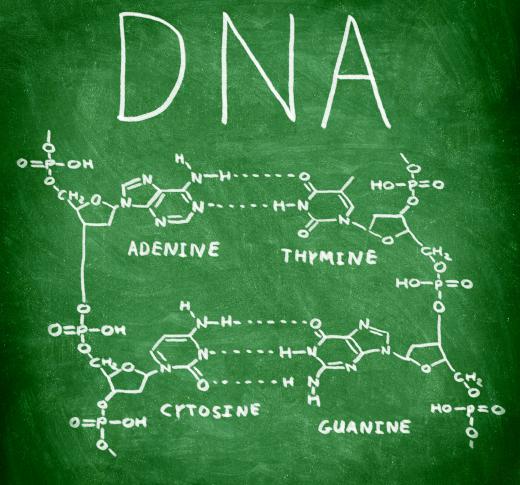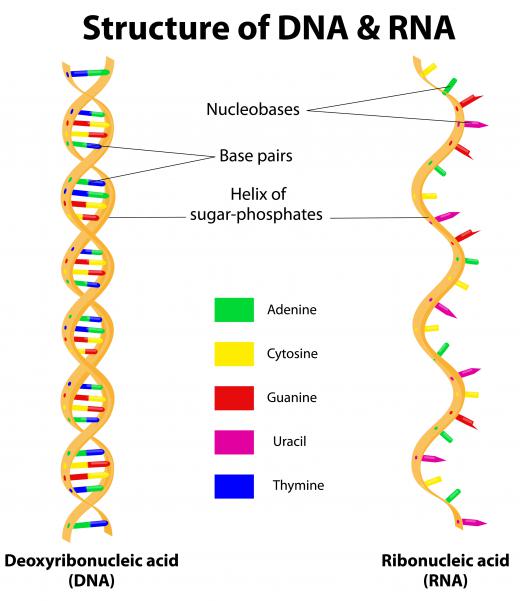What is Guanine?
Nucleotides are complex molecules that are the building blocks for deoxyribonucleic acid (DNA) and ribonucleic acid (RNA). Each nucleotide has three parts - a five carbon sugar, a phosphate group and an organic base. There are two variations of the sugar, depending on whether the nucleotide is in a DNA or RNA molecule. Also, one of five different organic bases can be attached to each nucleotide - adenine, cytosine, guanine, thymine or uracil. Cytosine, guanine and adenine are found in both RNA and DNA molecules, while thymine is only in DNA and uracil is only in RNA.
All five of the bases have a complex ring structure made up of carbon and nitrogen atoms. Due to the nitrogen atoms found in the ring, the bases are also referred to as nitrogenous bases. Each of the bases has a chemical structure that differs from the other four, which allows for specific base pairing between each of the bases.

The five bases can be split into two groups based on the number of rings found in their chemical structure. Purine bases are made up of two rings of atoms and pyrimidine bases have only one ring of atoms. The purine bases include adenine and guanine, while the pyrimidine bases are cytosine, thymine and uracil. When the bases pair and bond together, purine bases only bond with pyrimidine bases. More specifically, adenine only bonds with thymine or uracil and cytosine only bonds with guanine.

This specific base pairing is very important for the stability of a DNA molecule, which is made up of two strands of nucleotides that spiral together to form a double helix. The two strands are held together by hydrogen bonds between complementary bases on each strand. Adenine and thymine are attached by two hydrogen bonds, while guanine and cytosine are bonded by three hydrogen bonds. Only these pairs are capable of forming the required hydrogen bonds to make the molecule of DNA stable.

By bonding occurring only between purine bases and pyrimidine bases, the distance between the two strands remains uniform, adding further stability to the DNA molecule. When a purine base bonds with a pyrimidine base, a double ring molecule bonds to a single ring molecule. If a purine base were to bond with a purine base, then two double ring molecules would be attached, or if a pyrimidine base bonded to a pyrimidine base, then two single ring molecules would be attached. If all these bonding scenarios occurred, the DNA molecule would bow in and out and not be uniform, which would affect its overall structure and stability. Having a stable DNA molecule is imperative for success, as it carries the genetic information for each organism.
AS FEATURED ON:
AS FEATURED ON:













Discussion Comments
The advances in DNA study in just the past 40 years or so are astounding. We're even learning to switch chromosomes on and off to help prevent or cure diseases! It is an awesome responsibility we've created for ourselves, and we need to remember the gravity of what we're doing.
I learned the CTAG code in ninth grade biology. My teacher would be so proud that I remember all four components a bunch of years later.
All you have to do is look at the DNA double helix, in my opinion, to see a creative, intelligent force behind it. A tornado in a junkyard won't put together a brand new Mercedes and chaos doesn't produce something this beautiful and precise.
Post your comments